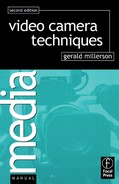Today’s cameras seem to provide satisfactory pictures with almost any kind of lighting. So why do we need to introduce special lighting equipment? Well, the results when using natural or existing ‘available light’ are very unpredictable. Properly arranged lighting has important advantages:
• It allows the camera to produce optimum picture quality.
• It makes various features of the subject visible; revealing its form, texture, shadow detail.
• It can be used selectively, to show or conceal the features you choose.
• It can deliberately enhance or degrade the appearance of a subject or a scene.
• It creates an illusion of dimension, space and depth.
• It conveys an environmental effect. It creates an atmosphere.
• It can produce very consistent artistic quality, even when camera angles change.
Light intensities and contrast
Insufficient light, results in underexposed grainy (‘noisy’) pictures. If scenic tones are too contrasted, or there are overbright areas with deep shadows, the camera will not be able to handle the contrast range. You can accept this, keep the extremes out of shot, or light the shadows.
Avoid shooting into bright areas when using auto-iris. It will close, and underexpose the shot. Closing drapes over daylit windows, or changing the camera’s position to exclude such surfaces often helps. You may have to place the camera to suit the prevailing light, rather than the best view of the subject. Perhaps you can angle the subject to suit the light.
The direction of light considerably affects a subject’s appearance. Always think of its angle relative to the camera’s position. Whenever the camera or the light repositions, the pictorial effect changes correspondingly:
• Frontal lighting from behind the camera, suppresses surface modeling and texture.
• Side light shining across the subject will emphasize or exaggerate surface contours and texture, often creating a crude bisected effect.
• Back light pointing towards the camera will put a rim of light around the subject, to separate it from its background, and reveal any transparency or translucency.
Light from any angle will have some of these characteristics depending on which of these three basic directions it most resembles. As the height of a light source increases, modeling and downward shadows become increasingly harsh.
The light’s color quality affects color fidelity of the picture. Orange-yellow light such as candlelight (low color temperature) is at the lower end of the Kelvin scale. Bluish daylight (high color temperature) at the upper end.
If your camera’s color balance (red-green-blue proportions) does not match the prevailing light, the picture will have a color cast and appear unnaturally blue or orange-yellow. White balance (auto-white) circuits or corrective color filters will adjust the error, matching the system to either daylight or tungsten illumination – but not both. If several types of light are intermixed (e.g. daylight, tungsten, fluorescent) there will be color errors in surfaces lit by the uncorrected sources.
There are two fundamental light characteristics:
• Hard light – which casts well-defined shadows, creates modeling, and reveals form. It comes from concentrated (point) sources.
• Soft light – which ideally is entirely shadowless, illuminating without casting any shadows. It comes from broad, large-area, diffused sources. Most successful lighting is a blend of these two forms.
1. Reflector board – The simplest portable device used for supplementary lighting. Strongly reflected hard light from its shiny side; soft diffused light from its matte surface. Useful for diverting sunlight onto a subject. Particularly valuable when shooting sunny exteriors, for a reflector will provide an effective key or fill light, yet use no power source.
2. Camera light (video light) – A small spotlight attached to the camera; (100–350 W).
3. Sun gun – A small hand-held spotlight directed by a second operator. Run from battery or utility power supplies; (e.g. 250–1000 W). May have a diffuser and corrective filters.
4. External reflector spotlight (lensless spot; Redhead; Blonde) – A lightweight spotlight supported on a collapsible extending tripod stand; (250 W, 600 W, 800 W).
5. Broad – A small trough light (500 W – 1000 W or more) which covers a wide area with comparatively soft light.

